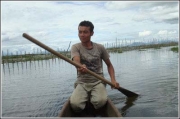/topics/surface-water
Surface Water
Ecological destruction of Loktak, the largest freshwater lake in North East India – A five-part FES-InfoChange series
Posted on 13 Nov, 2010 07:18 PM This series by Thingnam Anjulika Samom deals with the impact of modernisation, development and state policy on the traditional use, control and management of Loktak lake, the largest common property aquatic resource in Manipur. The Loktak Hydropower Project commissioned in 1983 has damaged the ecology of the largest freshwater lake in the northeast, and has altered the culture, agricultural and livelihood patterns of communities residing around Loktak. The series looks at what this common property resource used to be and what it has become.
This series by Thingnam Anjulika Samom deals with the impact of modernisation, development and state policy on the traditional use, control and management of Loktak lake, the largest common property aquatic resource in Manipur. The Loktak Hydropower Project commissioned in 1983 has damaged the ecology of the largest freshwater lake in the northeast, and has altered the culture, agricultural and livelihood patterns of communities residing around Loktak. The series looks at what this common property resource used to be and what it has become.
Loktak, the 300-square-km lake is spread over three districts in the valley – Imphal West, Bisnupur and Thoubal and covers 61% of the total identified wetlands of Manipur. Besides being the source of livelihood for hundreds of people, Loktak also houses the floating national park Keibul Lamjao, the only home in the world to the endangered Sangai deer. It is not only the geographical topography of the lake that has changed in the last few decades. The lake is also beset by increasing pollution, siltation, rapid proliferation of phumdis and the commissioning of the Loktak hydel project in the 1980s Manipur or Imphal River, with the Loktak lake forming the headwaters to provide regulated storage for power generation.
Storage above design full tank level in Pichola-Swaroop Saagar and Fatah Saagar lakes of Udaipur - A threat to safety
Posted on 10 Nov, 2010 10:02 PMThe historical lakes of Udaipur, Rajasthan, namely Pichola - Swaroop Saagar and Fatah Saagar are more than a century old. Filling them above original design full tank level on public demand or over enthusiasm may prove to be a threat to safety.
Training program on analysis and design of dams, NWA, Pune
Posted on 04 Nov, 2010 05:20 PMOrganizer: National Water Academy (NWA)
Training program on preparation of detailed project report, NWA, Pune
Posted on 04 Nov, 2010 04:39 PMOrganizer: National Water Academy (NWA)
News roundup (22 - 31 October 2010) :" India: Land of many cell phones, but fewer toilets"
Posted on 03 Nov, 2010 08:50 AMWastewater/Sanitation
Save Ganga and Save Himalayas Yatra, Save Ganga Movement, New Delhi
Posted on 25 Oct, 2010 03:11 PMOrganizer: Save Ganga Movement
Topics:
The Maharashtra groundwater (regulation for drinking water purposes) act - International Environmental Law Research Centre (1993)
Posted on 22 Oct, 2010 05:09 PMThe document describes the Maharashtra Groundwater Act, which is an Act to regulate the exploitation of groundwater for the protection of public drinking water sources and includes the details of :
- Short title and commencement of the Act
- Definitions of the terms used in the Act
- Protection measures for public drinking water sources
- Prohibition of construction of wells within certain limits
- Declaration of water scarcity area
- Regulation of extraction of water from wells in water scarcity areas
- Declaration of over exploited watershed
- Prohibition of sinking of well in over exploited watershed
- Prohibition of extraction of water from an existing well for certain period
- Closing down existing well
- Power of entry upon any land for obtaining information
- Power to stop contravention of the provisions of section 3, 5, 7, 8 or 9
- Payment of compensation
- Bar to claim compensation
Urban local initiatives and government responses: A case of Dev Nadi in Pune
Posted on 21 Oct, 2010 01:26 PMMost of the rivers and streams in urban India are dead. With a very few and rare exceptions, these once-beautiful water bodies have been encroached upon, sources dried up or converted into sewage drains all over the country.Water is being sourced or pumped from sites upstream of the city for its needs or from long distances and the city administration has little incentive for cleaning its own muck. The dismal figures of urban sewage treated by sewage treatment plants, their installed capacity and efficiency stand testimony to this.
Orissa: Jajpur and Kendrapara districts in the grip of water crisis due to indiscriminate use of water by industries in Kalinga Nagar : News roundup (7-14 October 2010)
Posted on 15 Oct, 2010 10:22 AMWater for Industry
Climate Change/Environment
A story telling and discussion on rivers, peoples and dams, Ants Crafting Traditions, Bangalore
Posted on 14 Oct, 2010 03:39 PMOrgnizer: The Ants Crafting Traditions





